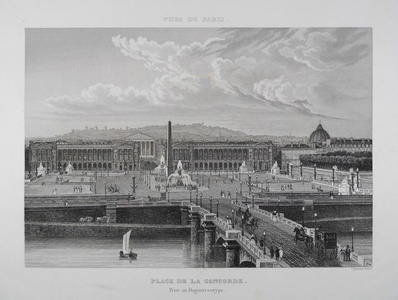| Method | Steel engraving |
| Artist | Jean Baptiste Marie Chamouin |
| Published | Chamouin, Rue de la Harpe, 29. Paris, 1845 |
| Dimensions | Image 155 x 230 mm, Plate 230 x 292 mm, Sheet 250 x 350 mm |
| Notes |
A topographical view of Paris, Plate 1 from the publication "Collection De Vues De Paris Prises Au Daguerreotype : Gravures En Taille Douce Sur Acier Jean Baptiste Marie Chamouin" or (Collection Of Views Of Paris by Daguerreotype : Engravings In Etching Of Steel by Jean Baptiste Marie Chamouin). This plate depicts a view of Place De La Concorde. Place De La Concorde, completed in 1772, is Paris' largest square measuring 21.3 acres. Designed by Ange-Jacques Gabriel in 1755, Place de la Concorde was originally named Place Louis XV in honour of the King at that time. During the French Revolution the infamous guillotine was placed in the square where the King King Louis XVI was executed on 21 January 1793. Queen Marie Antoinette was also executed on this site along with numerous other important aristocracy during the Revolution. "Collection De Vues De Paris Prises Au Daguerreotype : Gravures En Taille Douce Sur Acier Jean Baptiste Marie Chamouin" was a volume of steel-engraved perspective views of some of the principal buildings and landmarks of Paris, based on daguerreotype photographs. Daguerreotype is a photograph taken by an early photographic process employing an iodine-sensitized silvered plate and mercury vapour. Daguerreotypes were able to catch incredible detail in the image which the artist could then transfer in such detail to the engraving. Due to the long exposure time of the photographs, the figures depicted within the prints were added by hand later. |
| Framing | unmounted |
| Price | £40.00 |
| Stock ID | 41545 |

